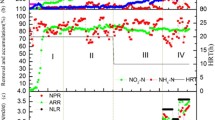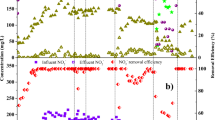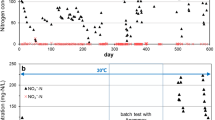Abstract
Nitrous oxide (N2O) is a potent greenhouse gas that can be emitted during the biological treatment of wastewater. In this study, a comparison of the long-term performance characteristics and N2O production of sequencing batch reactors (SBR) and continuous stirred tank reactors (CSTR) during nitrite-based denitrification was undertaken. It was found that both reactors had NO2−-N removal efficiencies over 99.9 %, but the N2O-N emissions from the SBR reached ∼2.3 % of the removal nitrite-N load, while in the CSTR it never exceeded 0.1 %. High frequency sampling during one operation cycle of the SBR demonstrated that the N2O accumulation ratio was ∼0.1 % during the feast period, increased to ∼1.9 % in the first five hours of the famine period, and then gradually reached ∼2.3 % at the end of famine. Batch experiments showed that limiting extracellular electron donor is required for N2O accumulation in cells from the SBR-famine period and that cells from the CSTR do not accumulate N2O when either nitrite or carbon is limiting. Another notable difference in the two reactor communities was the high level of accumulation of intracellular granules, most likely polyhydroxybutyrate (PHB), in cells during the feast period in the SBR. Metagenome assembly and binning found that one genome (PRO1), which is a Thauera, accounted for over half the metagenomic reads in both reactors. Neither shifts in gene regulation nor community composition explained the observed differences in reactor performance suggesting some post-transcriptional regulation obligatorily linked to antecedent conditions underly increased N2O production in the SBR.

Similar content being viewed by others
References
Anburajan P, Naresh Kumar A, Sabapathy P C, Kim G B, Cayetano R D, Yoon J J, Kumar G, Kim S H (2019). Polyhydroxy butyrate production by Acinetobacter junii BP25, Aeromonas hydrophila ATCC 7966, and their co-culture using a feast and famine strategy. Bioresource Technology, 293: 122062
APHA (1998). Standard Methods for the Examinations of Water and Wastewater. Washington, DC: American Public Health Association
Arkin A P, Cottingham R W, Henry C S, Harris N L, Stevens R L, Maslov S, Dehal P, Ware D, Perez F, Canon S, et al. (2018). KBase: The United States department of energy systems biology knowledgebase. Nature Biotechnology, 36(7): 566–569
Bergaust L, Shapleigh J, Frostegård A, Bakken L (2008). Transcription and activities of NOx reductases in Agrobacterium tumefaciens: the influence of nitrate, nitrite and oxygen availability. Environmental Microbiology, 10(11): 3070–3081
Bhattacharjee A S, Wu S, Lawson C E, Jetten M S M, Kapoor V, Domingo J W S, McMahon K D, Noguera D R, Goel R (2017). Whole-community metagenomics in two different anammox configurations: process performance and community structure. Environmental Science & Technology, 51(8): 4317–4327
Bollon J, Filali A, Fayolle Y, Guerin S, Rocher V, Gillot S (2016). N2O emissions from full-scale nitrifying biofilters. Water Research, 102: 41–51
Buchfink B, Xie C, Huson D H (2015). Fast and sensitive protein alignment using DIAMOND. Nature Methods, 12(1): 59–60
Colpa D I, Zhou W, Wempe J P, Tamis J, Stuart M C A, Krooneman J, Euverink G W (2020). Thauera aminoaromatica MZ1T identified as a polyhydroxyalkanoate-producing bacterium within a mixed microbial consortium. Bioengineering (Basel, Switzerland), 7(1): 19
Conthe M, Lycus P, Arntzen M O, Ramos da Silva A, Frostegård Å, Bakken L R, Kleerebezem R, van Loosdrecht M C M (2019). Denitrification as an N2O sink. Water Research, 151: 381–387
Conthe M, Wittorf L, Kuenen J G, Kleerebezem R, van Loosdrecht M C M, Hallin S (2018). Life on N2O: deciphering the ecophysiology of N2O respiring bacterial communities in a continuous culture. ISME Journal, 12(4): 1142–1153
Corsino S F, Campo R, Di Bella G, Torregrossa M, Viviani G (2016). Study of aerobic granular sludge stability in a continuous-flow membrane bioreactor. Bioresource Technology, 200: 1055–1059
D’Alessio M, Nordeste R, Doxey A C, Charles T C (2017). Transcriptome analysis of polyhydroxybutyrate cycle mutants reveals discrete loci connecting nitrogen utilization and carbon storage in Sinorhizobium meliloti. mSystems, 2(5): e00035–17
Dircks K, Henze M, van Loosdrecht M C M, Mosbaek H, Aspegren H (2001). Storage and degradation of poly-β-hydroxybutyrate in activated sludge under aerobic conditions. Water Research, 35(9): 2277–2285
Graf D R H, Jones C M, Hallin S (2014). Intergenomic comparisons highlight modularity of the denitrification pathway and underpin the importance of community structure for N2O emissions. PLoS One, 9(12): e114118
Hegarty T W (1973). Temperature coefficient (Q10), seed germination and other biological processes. Nature, 243: 305–306
Henze M, Gujer W, Mino T, Van Loosedrecht M (2000). Activated Sludge Models ASM1, ASM2, ASM2d and ASM3. Scientific & Technical Report IWA Publishing, 9. Diepoldsau, Switzerland: IWA Publishing ISBN: 9781900222242
Heo S, Liu Y Q (2021). Dependence of poly-β-hydroxybutyrate accumulation in sludge on biomass concentration in SBRs. Science of the Total Environment, 797: 149138
Hu Q, Fan L R, Gao D W (2017). Pilot-scale investigation on the treatment of cellulosic ethanol biorefinery wastewater. Chemical Engineering Journal, 309: 409–416
Huang W, Zhou J, He X, He L, Lin Z, Shi S, Zhou J (2021). Simultaneous nitrogen and phosphorus removal from simulated digested piggery wastewater in a single-stage biofilm process coupling anammox and intracellular carbon metabolism. Bioresource Technology, 333: 125152
Hyatt D, Chen G L, Locascio P F, Land M L, Larimer F W, Hauser L J (2010). Prodigal: prokaryotic gene recognition and translation initiation site identification. BMC Bioinformatics, 11(1): 119
IPCC (2019). 2019 Refinement to the 2006 IPCC Guidelines for National Greenhouse Gas Inventories, Chapter 6: Wastewater Treatment and Discharge. Bangkok: IPCC, 72
Jia Y, Zhou M, Chen Y, Hu Y, Luo J (2020). Insight into short-cut of simultaneous nitrification and denitrification process in moving bed biofilm reactor: effects of carbon to nitrogen ratio. Chemical Engineering Journal, 400: 125905
Jiang X, Mira D, Cluff D L (2018). The combustion mitigation of methane as a non-CO2 greenhouse gas. Progress in Energy and Combustion Science, 66: 176–199
Jones C M, Graf D R, Bru D, Philippot L, Hallin S (2013). The unaccounted yet abundant nitrous oxide-reducing microbial community: a potential nitrous oxide sink. ISME Journal, 7(2): 417–426
Jones M, Stephenson T (1996). The effects of temperature on enhanced biological phosphate removal. Environmental Technology, 17(9): 965–976
Kang D D, Froula J, Egan R, Wang Z (2015). MetaBAT, an efficient tool for accurately reconstructing single genomes from complex microbial communities. PeerJ, 3(8): e1165
Kent T R, Bott C B, Wang Z W (2018). State of the art of aerobic granulation in continuous flow bioreactors. Biotechnology Advances, 36(4): 1139–1166
Langmead B, Salzberg S L (2012). Fast gapped-read alignment with Bowtie 2. Nature Methods, 9(4): 357–359
Larriba O, Rovira-Cal E, Juznic-Zonta Z, Guisasola A, Baeza J A (2020). Evaluation of the integration of P recovery, polyhydroxyalkanoate production and short cut nitrogen removal in a mainstream wastewater treatment process. Water Research, 172: 115474
Li D, Liu C M, Luo R, Sadakane K, Lam T W (2015). MEGAHIT: an ultra-fast single-node solution for large and complex metagenomics assembly via succinct de Bruijn graph. Bioinformatics (Oxford, England), 31(10): 1674–1676
Li W, Cai Z Y, Duo Z J, Lu Y F, Gao K X, Abbas G, Zhang M, Zheng P (2017). Heterotrophic ammonia and nitrate bio-removal over nitrite (Hanbon): performance and microflora. Chemosphere, 182: 532–538
Li W, Li H, Liu Y D, Zheng P, Shapleigh J P (2018a). Salinity-aided selection of progressive onset denitrifiers as a means of providing nitrite for anammox. Environmental Science & Technology, 52(18): 10665–10672
Li W, Liu S, Zhang M, Zhao H P, Zheng P (2018b). Oxidation of organic electron donor by denitratation: performance, pathway and key microorganism. Chemical Engineering Journal, 343: 554–560
Li W, Zhuang J L, Zhou Y Y, Meng F G, Kang D, Zheng P, Shapleigh J P, Liu Y D (2020). Metagenomics reveals microbial community differences lead to differential nitrate production in anammox reactors with differing nitrogen loading rates. Water Research, 169: 115279
Liu B, Mao Y, Bergaust L, Bakken L R, Frostegård A (2013). Strains in the genus Thauera exhibit remarkably different denitrification regulatory phenotypes. Environmental Microbiology, 15(10): 2816–2828
Lopez M L D, Lin Y Y, Sato M, Hsieh C H, Shiah F K, Machida R J (2022). Using metatranscriptomics to estimate the diversity and composition of zooplankton communities. Molecular Ecology Resources, 22(2): 638–652
Lycus P, Lovise Bøthun K, Bergaust L, Peele Shapleigh J, Reier Bakken L, Frostegård Å (2017). Phenotypic and genotypic richness of denitrifiers revealed by a novel isolation strategy. ISME Journal, 11(10): 2219–2232
Ma C, Jensen M M, Smets B F, Thamdrup B (2017). Pathways and controls of N2O production in nitritation-anammox biomass. Environmental Science & Technology, 51(16): 8981–8991
Nurk S, Meleshko D, Korobeynikov A, Pevzner P A (2017). metaSPAdes: a new versatile metagenomic assembler. Genome Research, 27(5): 824–834
Obruca S, Sedlacek P, Mravec F, Krzyzanek V, Nebesarova J, Samek O, Kucera D, Benesova P, Hrubanova K, Milerova M, Marova I (2017). The presence of PHB granules in cytoplasm protects non-halophilic bacterial cells against the harmful impact of hypertonic environments. New Biotechnology, 39(Pt A): 68–80
Olm M R, Brown C T, Brooks B, Banfield J F (2017). dRep: a tool for fast and accurate genomic comparisons that enables improved genome recovery from metagenomes through de-replication. ISME Journal, 11(12): 2864–2868
Olm M R, Crits-Christoph A, Bouma-Gregson K, Firek B A, Morowitz M J, Banfield J F (2021). in Strain profiles population microdiversity from metagenomic data and sensitively detects shared microbial strains. Nature Biotechnology, 39(6): 727–736
Pagáčová P, Galbová K, Drtil M, Jonatová I (2010). Denitrification in USB reactor with granulated biomass. Bioresource Technology, 101(1): 150–156
Pertea M, Pertea G M, Antonescu C M, Chang T C, Mendell J T, Salzberg S L (2015). StringTie enables improved reconstruction of a transcriptome from RNA-seq reads. Nature Biotechnology, 33(3): 290–295
Philippot L, Andert J, Jones C M, Bru D, Hallin S (2011). Importance of denitrifiers lacking the genes encoding the nitrous oxide reductase for N2O emissions from soil. Global Change Biology, 17(3): 1497–1504
Qiu S J, Liu J J, Zhang L, Zhang Q, Peng Y Z (2021). Sludge fermentation liquid addition attained advanced nitrogen removal in low C/N ratio municipal wastewater through short-cut nitrification-denitrification and partial anammox. Frontiers of Environmental Science & Engineering, 15(2): 26
Quagliano J C, Miyazaki S S (1997). Effect of aeration and carbon/nitrogen ratio on the molecular mass of the biodegradable polymer poly-β-hydroxybutyrate obtained from Azotobacter chroococcum 6B. Applied Microbiology and Biotechnology, 48(5): 662–664
Ren T, Chi Y, Wang Y, Shi X, Jin X, Jin P (2021). Diversified metabolism makes novel Thauera strain highly competitive in low carbon wastewater treatment. Water Research, 206: 117742
Roco C A, Bergaust L L, Bakken L R, Yavitt J B, Shapleigh J P (2017). Modularity of nitrogen-oxide reducing soil bacteria: linking phenotype to genotype. Environmental Microbiology, 19(6): 2507–2519
Rombouts J L, Mos G, Weissbrodt D G, Kleerebezem R, Van Loosdrecht M C M (2019). Diversity and metabolism of xylose and glucose fermenting microbial communities in sequencing batch or continuous culturing. FEMS Microbiology Ecology, 95(2): fiy233
Sanford R A, Wagner D D, Wu Q, Chee-Sanford J C, Thomas S H, Cruz-García C, Rodríguez G, Massol-Deyá A, Krishnani K K, Ritalahti K M, Nissen S, Konstantinidis K T, Löffler F E (2012). Unexpected nondenitrifier nitrous oxide reductase gene diversity and abundance in soils. Proceedings of the National Academy of Sciences of the United States of America, 109(48): 19709–19714
Sarmiento-Pavía P D, Sosa-Torres M E (2021). Bioinorganic insights of the PQQ-dependent alcohol dehydrogenases. European Journal of Biochemistry, 26(2–3): 177–203
Schalk-Otte S, Seviour R J, Kuenen J G, Jetten M S M (2000). Nitrous oxide (N2O) production by Alcaligenes faecalis during feast and famine regimes. Water Research, 34(7): 2080–2088
Scherson Y D, Wells G F, Woo S G, Lee J, Park J, Cantwell B J, Criddle C S (2013). Nitrogen removal with energy recovery through N2O decomposition. Energy & Environmental Science, 6(1): 241–248
Scherson Y D, Woo S G, Criddle C S (2014). Production of nitrous oxide from anaerobic digester centrate and its use as a co-oxidant of biogas to enhance energy recovery. Environmental Science & Technology, 48(10): 5612–5619
Shen X Y, Zhuge Y Y, Liu Y D, Shapleigh J P, Li W (2021). Long-term effects of acetylene on denitrifying N2O production: Biomass performance and microbial community. Journal of Water Process Engineering, 42: 102137
Sun Y, Angelotti B, Brooks M, Wang Z W (2021). Feast/famine ratio determined continuous flow aerobic granulation. Science of the Total Environment, 750: 141467
Tian H, Xu R, Canadell J G, Thompson R L, Winiwarter W, Suntharalingam P, Davidson E A, Ciais P, Jackson R B, Janssens-Maenhout G, et al. (2020). A comprehensive quantification of global nitrous oxide sources and sinks. Nature, 586(7828): 248–256
Trainer M A, Capstick D, Zachertowska A, Lam K N, Clark S R D, Charles T C (2010). Identification and characterization of the intracellular poly-3-hydroxybutyrate depolymerase enzyme PhaZ of Sinorhizobium meliloti. BMC Microbiology, 10(1): 92
Wang J P, Liu Y D, Meng F G, Li W (2020). The short- and long-term effects of formic acid on rapid nitritation start-up. Environment International, 135: 105350
Wang Q, He J (2020). Complete nitrogen removal via simultaneous nitrification and denitrification by a novel phosphate accumulating Thauera sp. strain SND5. Water Research, 185: 116300
Xu Z, Dai X, Chai X (2018). Effect of different carbon sources on denitrification performance, microbial community structure and denitrification genes. Science of the Total Environment, 634: 195–204
Yang Q, Cui B, Zhou Y, Li J, Liu Z, Liu X (2020). Impact of gas-water ratios on N2O emissions in biological aerated filters and analysis of N2O emissions pathways. Science of the Total Environment, 723: 137984
Zhang J, Zhang Y, Quan X (2012). Electricity assisted anaerobic treatment of salinity wastewater and its effects on microbial communities. Water Research, 46(11): 3535–3543
Zhou F, Xiao W Z, Zhou K Y, Zhuang J L, Zhang X, Liu Y D, Ni B J, Shapleigh J P, Zhou M, Luo X Z, Li W (2022). Performance characteristics and community analysis of a single-stage partial nitritation, anammox and denitratation (SPANADA) integrated process for treating low C/N ratio wastewater. Chemical Engineering Journal, 433: 134452
Zhuang J L, Sun X, Zhao W Q, Zhang X, Zhou J J, Ni B J, Liu Y D, Shapleigh J P, Li W (2022). The anammox coupled partial-denitrification process in an integrated granular sludge and fixed-biofilm reactor developed for mainstream wastewater treatment: Performance and community structure. Water Research, 210: 117964
Zhuang J L, Zhou Y Y, Liu Y D, Li W (2020). Flocs are the main source of nitrous oxide in a high-rate anammox granular sludge reactor: insights from metagenomics and fed-batch experiments. Water Research, 186: 116321
Zhuge Y Y, Shen X Y, Liu Y D, Shapleigh J, Li W (2020). Application of acidic conditions and inert-gas sparging to achieve high-efficiency nitrous oxide recovery during nitrite denitrification. Water Research, 182: 116001
Acknowledgements
This work was supported by the National Natural Science Foundation of China (No. 52170076), the Shanghai Rising-Star Program (China) (No. 20QC1400500), and the State Key Laboratory of Pollution Control and Resource Reuse (China) (No. PCRRF20024).
Author information
Authors and Affiliations
Corresponding author
Additional information
Declaration of Competing Interest
The authors declare that there is no conflict of interest.
Highlights
• N2O emissions from a denitrifying SBR were 23 times higher than that of the CSTR.
• Feast famine conditions in SBR uniquely lead to producing undesirable levels of N2O.
• An MAG closely related to previously identified Thauera is likely a major N2O driver.
• Post-transcriptional regulation may be linked to higher N2O production in SBR.
Supplementary Information
11783_2023_1650_MOESM1_ESM.pdf
Higher N2O production in sequencing batch reactors compared to continuous stirred tank reactors: effect of feast-famine cycles
Rights and permissions
About this article
Cite this article
Yan, X., Shen, X., Wang, J. et al. Higher N2O production in sequencing batch reactors compared to continuous stirred tank reactors: effect of feast-famine cycles. Front. Environ. Sci. Eng. 17, 50 (2023). https://doi.org/10.1007/s11783-023-1650-z
Received:
Revised:
Accepted:
Published:
DOI: https://doi.org/10.1007/s11783-023-1650-z




